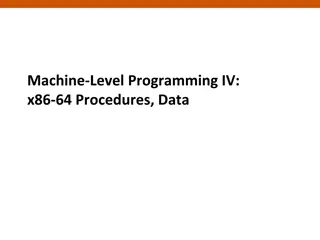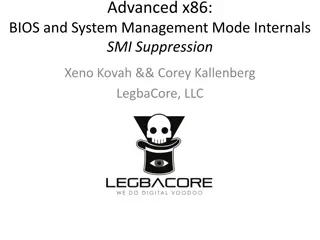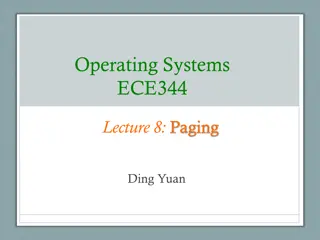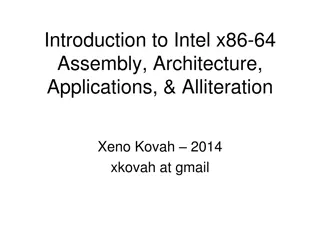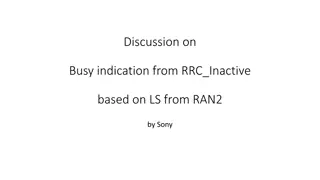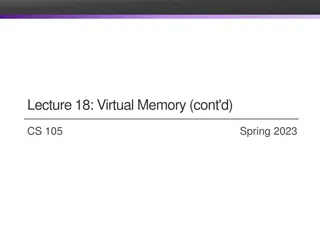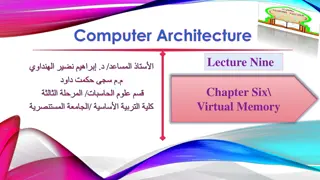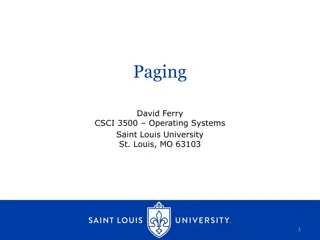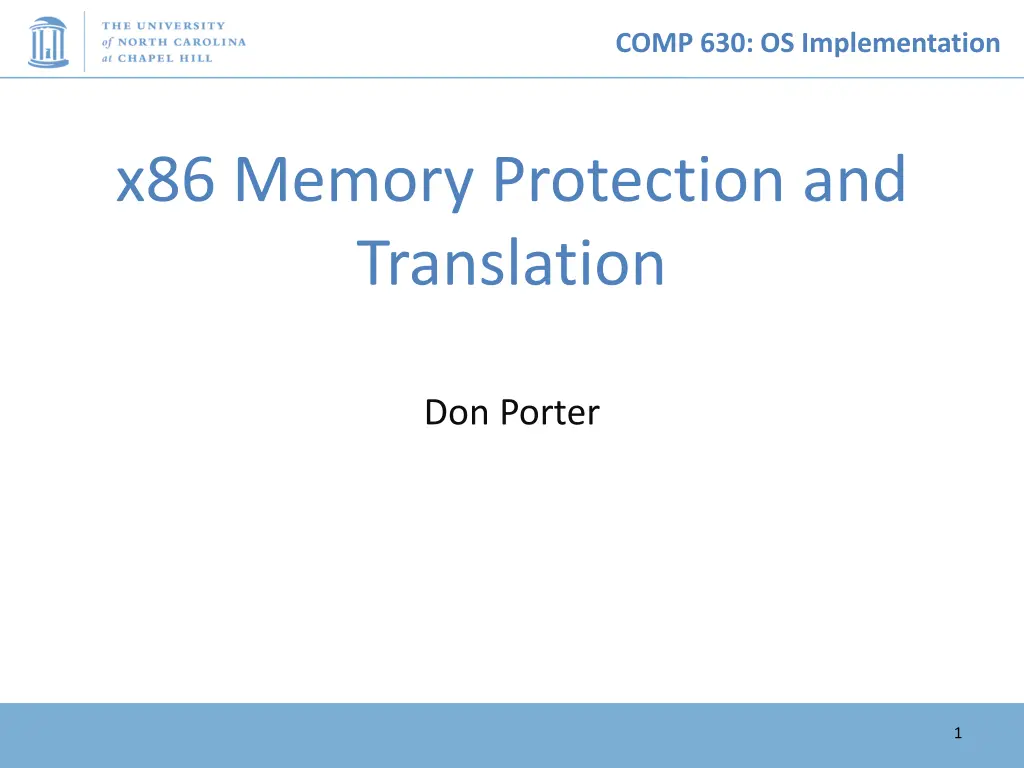
x86 Memory Protection and Translation in OS Implementation
Dive into the world of OS implementation with a focus on x86 memory protection and translation. Explore concepts like virtual memory, paging, and memory mapping on modern x86 processors. Discover the importance of preventing illegal operations and providing isolated virtual memory to programs.
Download Presentation

Please find below an Image/Link to download the presentation.
The content on the website is provided AS IS for your information and personal use only. It may not be sold, licensed, or shared on other websites without obtaining consent from the author. If you encounter any issues during the download, it is possible that the publisher has removed the file from their server.
You are allowed to download the files provided on this website for personal or commercial use, subject to the condition that they are used lawfully. All files are the property of their respective owners.
The content on the website is provided AS IS for your information and personal use only. It may not be sold, licensed, or shared on other websites without obtaining consent from the author.
E N D
Presentation Transcript
COMP 630: OS Implementation x86 Memory Protection and Translation Don Porter 1
COMP 630: OS Implementation Logical Diagram Memory Allocators Binary Formats Threads User System Calls Kernel Sync File System Networking RCU Memory Management CPU Device Drivers Lecture Today s Scheduler Hardware Interrupts Disk Net Consistency Today s Lecture: Focus on Hardware ABI 2
COMP 630: OS Implementation Lecture Goal Understand the hardware tools available on a modern x86 processor for manipulating and protecting memory Lab 2: You will program this hardware Apologies: Material can be a bit dry, but important Plus, slides will be good reference But, cool tech tricks: How does thread-local storage (TLS) work? An actual (and tough) Microsoft interview question 3
COMP 630: OS Implementation Undergrad Review What is: Virtual memory? Segmentation? Paging? 4
COMP 630: OS Implementation Memory Mapping Process 1 Process 2 Virtual Memory Virtual Memory // Program expects (*x) // to always be at // address 0x1000 int *x = 0x1000; 0x1000 Only one physical address 0x1000!! 0x1000 0x1000 Physical Memory 5
COMP 630: OS Implementation Two System Goals 1) Provide an abstraction of contiguous, isolated virtual memory to a program 2) Prevent illegal operations Prevent access to other application or OS memory Detect failures early (e.g., segfault on address 0) More recently, prevent exploits that try to execute program data 6
COMP 630: OS Implementation Outline x86 processor modes x86 segmentation x86 page tables Advanced Features Interesting applications/problems 7
COMP 630: OS Implementation x86 Processor Modes Real mode walks and talks like a really old x86 chip State at boot 20-bit address space, direct physical memory access 1 MB of usable memory Segmentation available (no paging) Protected mode Standard 32-bit x86 mode Segmentation and paging Privilege levels (separate user and kernel) 8
COMP 630: OS Implementation x86 Processor Modes Long mode 64-bit mode (aka amd64, x86_64, etc.) Very similar to 32-bit mode (protected mode), but bigger Restrict segmentation use Garbage collect deprecated instructions Chips can still run in protected mode with old instructions Even more obscure modes we won t discuss today 9
COMP 630: OS Implementation Translation Overview Segmentation 0xdeadbeef 0x0eadbeef 0x6eadbeef Paging Virtual Address Linear Address Physical Address Protected/Long mode only Segmentation cannot be disabled! But can be a no-op (aka flat mode) 10
COMP 630: OS Implementation x86 Segmentation A segment has: Base address (linear address) Length Permissions 11
COMP 630: OS Implementation Programming model Segments for: code, data, stack, extra A program can have up to 6 total segments Segments identified by registers: cs, ds, ss, es, fs, gs Prefix all memory accesses with desired segment: mov eax, ds:0x80 (load offset 0x80 from data into eax) jmp cs:0xab8 (jump execution to code offset 0xab8) mov ss:0x40, ecx (move ecx to stack offset 0x40) 12
COMP 630: OS Implementation Segmented Programming Pseudo-example ds:x = 1; // data ss:y; // stack if (ds:x) { ss:y = 1; cs:printf (ds: Boo ); } else ss:y = 0; // global int x = 1 int y; // stack if (x) { y = 1; printf ( Boo ); } else y = 0; Segments would be used in assembly, not C 13
COMP 630: OS Implementation Programming, cont. This is cumbersome, so infer code, data and stack segments by instruction type: Control-flow instructions use code segment (jump, call) Stack management (push/pop) uses stack Most loads/stores use data segment Extra segments (es, fs, gs) must be used explicitly 14
COMP 630: OS Implementation Segment management For safety (without paging), only the OS should define segments. Why? Two segment tables the OS creates in memory: Global any process can use these segments Local segment definitions for a specific process How does the hardware know where they are? Dedicated registers: gdtr and ldtr Privileged instructions: lgdt, lldt 15
COMP 630: OS Implementation Segment registers Global or Local Table? (1 bit) Table Index (13 bits) Ring (2 bits) Set by the OS on fork, context switch, etc. 16
COMP 630: OS Implementation Segments Illustrated Low 3 bits 0 Index 1 (4th bit) cs: 0x8 ds: 0xf 0, 0B 0x123000, 1MB 0x423000, 1MB gdtr call cs:0xf150 0x123000 + 0xf150 = 0x123150 17
COMP 630: OS Implementation Sample Problem: (Old) JOS Bootloader Suppose my kernel is compiled to be in upper 256 MB of a 32-bit address space (i.e., 0xf0100000) Common to put OS kernel at top of address space Bootloader starts in real mode (only 1MB of addressable physical memory) Bootloader loads kernel at 0x00100000 Can t address 0xf0100000 18
COMP 630: OS Implementation Booting problem Kernel needs to set up and manage its own page tables Paging can translate 0xf0100000 to 0x00100000 But what to do between the bootloader and kernel code that sets up paging? 19
COMP 630: OS Implementation Segmentation to the Rescue! kern/entry.S: What is this code doing? mygdt: SEG_NULL # null seg SEG(STA_X|STA_R, -KERNBASE, 0xffffffff) # code seg SEG(STA_W, -KERNBASE, 0xffffffff) # data seg 20
COMP 630: OS Implementation JOS ex 1, cont. SEG(STA_X|STA_R, -KERNBASE, 0xffffffff) # code seg Execute and Read permission Offset Segment Length (4 GB) -0xf0000000 jmp 0xf01000db8 # virtual addr. (implicit cs seg) jmp (0xf01000db8 + -0xf0000000) jmp 0x001000db8 # linear addr. 21
COMP 630: OS Implementation Flat segmentation The above trick is used for booting. We eventually want to use paging. How can we make segmentation a no-op? From kern/pmap.c: // 0x8 - kernel code segment [GD_KT >> 3] = SEG(STA_X | STA_R, 0x0, 0xffffffff, 0), Execute and Read permission Offset Segment Length (4 GB) Ring 0 0x00000000 22
COMP 630: OS Implementation Outline x86 processor modes x86 segmentation x86 page tables Advanced Features Interesting applications/problems 23
COMP 630: OS Implementation Paging Model 32 (or 64) bit address space. Arbitrary mapping of linear to physical pages Pages are most commonly 4 KB Newer processors also support page sizes of 2 MB and 1 GB 24
COMP 630: OS Implementation How it works OS creates a page table Any old page with entries formatted properly Hardware interprets entries cr3 register points to the current page table Only ring0 can change cr3 25
COMP 630: OS Implementation Translation Overview From Intel 80386 Reference Programmer s Manual 26
COMP 630: OS Implementation Example 0xf1084150 0x3b4 0x84 0x150 Page Dir Offset (Top 10 addr bits: 0xf10 >> 2) Page Table Offset (Next 10 addr bits) Physical Page Offset (Low 12 addr bits) cr3 Entry at cr3+0x3b4 * sizeof(PTE) Entry at 0x84 * sizeof(PTE) Data we want at offset 0x150 27
COMP 630: OS Implementation Page Table Entries cr3 Physical Address Upper (20 bits) Flags (12 bits) 0x00384 PTE_W|PTE_P|PTE_U 0 0 0x28370 PTE_W|PTE_P 0 0 0 0 0 0 0 0 0 0 28
COMP 630: OS Implementation Page Table Entries Top 20 bits are the physical address of the mapped page Why 20 bits? 4k page size == 12 bits of offset Lower 12 bits for flags 29
COMP 630: OS Implementation Page flags 3 for OS to use however it likes 4 reserved by Intel, just in case 3 for OS to CPU metadata User/vs kernel page, Write permission, Present bit (so we can swap out pages) 2 for CPU to OS metadata Dirty (page was written), Accessed (page was read) 30
COMP 630: OS Implementation Page Table Entries User, writable, present cr3 Physical Address Upper (20 bits) Flags (12 bits) No mapping 0x00384 PTE_W|PTE_P|PTE_U 0 0 0x28370 PTE_W|PTE_P|PTE_DIRTY Writeable, kernel-only, present, and dirty (Dirty set by CPU on write) 31
COMP 630: OS Implementation Back of the envelope If a page is 4K and an entry is 4 bytes, how many entries per page? 1k How large of an address space can 1 page represent? 1k entries * 1page/entry * 4K/page = 4MB How large can we get with a second level of translation? 1k tables/dir * 1k entries/table * 4k/page = 4 GB Nice that it works out that way! 32
COMP 630: OS Implementation Challenge questions What is the space overhead of paging? I.e., how much memory goes to page tables for a 4 GB address space? What is the optimal number of levels for a 64 bit page table? When would you use a 2 MB or 1 GB page size? 33
COMP 630: OS Implementation TLB Entries The CPU caches address translations in the TLB Translation Lookaside Buffer cr3 Virt Phys 0xf0231000 0x00b31000 0xb0002000 0x1000 0x1f000 0xc1000 - - Page Traversal is Slow Table Lookup is Fast 34
COMP 630: OS Implementation TLB Entries The CPU caches address translations in the TLB Translation Lookaside BufferThe TLB is not coherent with memory, meaning: If you change a PTE, you need to manually invalidate cached values See the tlb_invalidate() function in JOS 35
COMP 630: OS Implementation TLB Entries The TLB is not coherent with memory, meaning: If you change a PTE, you need to manually invalidate cached values See the tlb_invalidate() function in JOS cr3 Virt Phys 0xf0231000 0x00b31000 0xb0002000 0x1000 0x1f000 0xc1000 - - Same Virt Addr. No Change!!! 36
COMP 630: OS Implementation Outline x86 processor modes x86 segmentation x86 page tables Advanced Features Interesting applications/problems 37
COMP 630: OS Implementation Physical Address Extension (PAE) Period with 32-bit machines + >4GB RAM (2000 s) Essentially, an early deployment of a 64-bit page table format Any given process can only address 4GB Including OS! Page tables themselves can address >4GB of physical pages 38
COMP 630: OS Implementation No execute (NX) bit Many security holes arise from bad input Tricks program to jump to unintended address That happens to be on heap or stack And contains bits that form malware Idea: execute protection can catch these Feels a bit like code segment, no? Bit 63 in 64-bit page tables (or 32 bit + PAE) 39
COMP 630: OS Implementation Nested page tables Paging tough for early Virtual Machine implementations Can t trust a guest OS to correctly modify pages So, add another layer of paging between host- physical and guest-physical 40
COMP 630: OS Implementation And now the fun stuff 41
COMP 630: OS Implementation Thread-Local Storage (TLS) // Global __thread int tid; printf ( my thread id is %d\n , tid); Identical code gets different value in each thread 42
COMP 630: OS Implementation Thread-local storage (TLS) Convenient abstraction for per-thread variables Code just refers to a variable name, accesses private instance Example: Windows stores the thread ID (and other info) in a thread environment block (TEB) Same code in any thread to access No notion of a thread offset or id How to do this? 43
COMP 630: OS Implementation TLS implementation Map a few pages per thread into a segment Use an extra segmentation register Usually gs Windows TEB in fs Any thread accesses first byte of TLS like this: mov eax, gs:(0x0) 44
COMP 630: OS Implementation TLS Illustration 0xb0002000 0xb0003000 0xb0001000 Tid = 0 Tid = 1 Tid = 2 Set by the OS kernel during context switch Thread 0 Registers gs: = 0xb0001000 Thread 1 Registers gs: = 0xb0002000 Thread 2 Registers gs: = 0xb0003000 printf ( My thread id is %d\n , gs:tid); 45
COMP 630: OS Implementation Viva segmentation! My undergrad OS course treated segmentation as a historical artifact Yet still widely (ab)used Also used for sandboxing in vx32, Native Client Used to implement early versions of VMware Counterpoint: TLS hack is just compensating for lack of general-purpose registers Either way, all but fs and gs are deprecated in x64 46
COMP 630: OS Implementation Microsoft interview question Suppose I am on a low-memory x86 system (<4MB). I don t care about swapping or addressing more than 4MB. How can I keep paging space overhead at one page? Recall that the CPU requires 2 levels of addr. translation 47
COMP 630: OS Implementation Solution sketch A 4MB address space will only use the low 22 bits of the address space. So the first level translation will always hit entry 0 Map the page table s physical address at entry 0 First translation will loop back to the page table Then use page table normally for 4MB space Assumes correct programs will not read address 0 Getting null pointers early is nice Challenge: Refine the solution to still get null pointer exceptions 48
COMP 630: OS Implementation Conclusion Lab 2 will be fun 49



